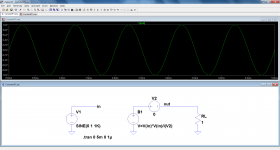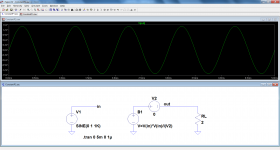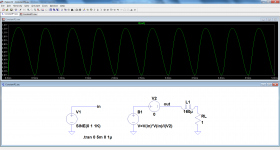The situation has changed completely: the circuit now shows its non-linear nature: to keep the power constant, it needs to alter its output impedance, leading to severe distortion of the current into the load.
Well you ask the amp to deliver a constant power, and then you complain that the current is nonlinear. That's not logical.
If you want constant power, you must look at the distortion in the power. How does that look?
jan
I always thought of doing "constant power" (have same rated power into 4/8 (DC resistance) ohm load) (not following the impedance curve of a speaker) by on amp startup, internal circuitry checks the resistance on the speaker terminals, modifies the power supply rails to the appropriate voltage, switches the amp on
I don't want constant power, I find the concept completely flawedWell you ask the amp to deliver a constant power, and then you complain that the current is nonlinear. That's not logical.
If you want constant power,
I always thought of doing "constant power" (have same rated power into 4/8 (DC resistance) ohm load) (not following the impedance curve of a speaker) by on amp startup, internal circuitry checks the resistance on the speaker terminals, modifies the power supply rails to the appropriate voltage, switches the amp on
What would be the advantage of that?
Jan
In my conceptual circuit, there is a strict proportionality between Vin² and Pout (which comes as no surprise since it has been designed for precisely that purpose). It is therefore perfectly linear.I know - I agree. But still, if you want to test an amp designed for constant power for linearity then you should look at the power, not at the current.
The problem is that the output impedance is non-linear, and if the load generates any kind of emf, through electromechanical transduction or reactive behavior it generates huge amounts of distortion, which somewhat defeats the usefulness (?) of the scheme
I find this topic very interesting, I am not so sure the ideal model is correct or not, but I believe it deserves some investigation. Looking at voltage source and current source amplifiers, each have their pros and cons. The logical place too look is power source.
Where can I find the flaming thread?
Where can I find the flaming thread?
Interesting. That is what a tube amp sine wave would look like? I can understand why some people would like it. But does a constant power source amplifier have to look like that?
Looking at the sine wave response, I think it will provide a good onset transient impression, but the trailing side is not so good.
Looking at the sine wave response, I think it will provide a good onset transient impression, but the trailing side is not so good.
Not necessarily: there are very well designed tube amplifiers: Williamson, etcInteresting. That is what a tube amp sine wave would look like?
There would be a number of different ways of implementing one, but even a perfect implementation would still be crippled by the theoretical flaws inherent to the principle: there is no escape from this.I can understand why some people would like it. But does a constant power source amplifier have to look like that?
It is basically a giant-size fuzz-boxLooking at the sine wave response, I think it will provide a good onset transient impression, but the trailing side is not so good.
It seems quite complicated to have a constant power amplified. If you are driving a speaker driver load with voltage source the voltage will remain common regardless of the impedance curve; if you use a current source, the current will remain constant regardless of load. For a power source, you need to define a voltage current ration which relates means a constant load. Does not seem too realistic. ... Unless you change the voltage current ratio with impedance change.
That is exactly what my examples do: the conceptual one does it perfectly, and the real one approximates closely this ideal, but the concept can only work properly on a purely resistive load, having no reactive component or back emf. Not really realistic for a loudspeaker.For a power source, you need to define a voltage current ration which relates means a constant load. Does not seem too realistic. ... Unless you change the voltage current ratio with impedance change.
I think if you are able to sense current and adjust voltage to get power, it might work. But looking this is better digitally done. I remember seeing a chip that feeds back power so you can effectively to a voltage controlled power output. Just that I have not gone into it too deeply. But it is a question whether it is worth it or not. There are lots of other issues in audio that are known issues which have not been worked on yet. I am amazed since I first started to play around with audio stuff back in the 80's, there are so much that needs to be handled. Now I get the fun of doing it to find out why.
Concept.
http://www.maximintegrated.com/en/app-notes/index.mvp/id/4470
not sure what the bandwidth of the device is.
I don't think I want to go into designing a wide band multiplier unless I know what to expect. Back in the old days when analog computers were used, circuits like these were quick simulation tools.
220kHz Bandwidth, Hmm. Anyone going to bite? I wonder if they have a spice model.
Concept.
http://www.maximintegrated.com/en/app-notes/index.mvp/id/4470
not sure what the bandwidth of the device is.
I don't think I want to go into designing a wide band multiplier unless I know what to expect. Back in the old days when analog computers were used, circuits like these were quick simulation tools.
220kHz Bandwidth, Hmm. Anyone going to bite? I wonder if they have a spice model.
Last edited:
It doesn't matter: if you do the voltage dual implementation instead of the current one, the end result is exactly the same:I think if you are able to sense current and adjust voltage to get power, it might work. But looking this is better digitally done..
First pic is "your" voltage implementation conceptualized.
Everything looks nice and shiny: if we double the load resistance, the voltage rises by √2, as expected.
But as soon as we introduce a reactive element or back emf, things turn sour.
It is the concept itself that is intrinsically flawed, not its implementation
Attachments
Certainly there are different views. I agree it is just easier to say "no" to the concept. I see lots of opportunities for improvement because people rejected various concepts in the past which I find fascinating once you have your hands around it. But if the thread starter already has his own conclusion, I see no purpose for continued discussion. I cannot even figure out why starting this thread?
- Status
- This old topic is closed. If you want to reopen this topic, contact a moderator using the "Report Post" button.
- Home
- Amplifiers
- Solid State
- The dark side of constant power amplifiers (and similar schemes)


